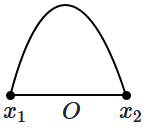The kinetic energy of a particle executing SHM is \(16~\text{J}\) when it is in its mean position. If the amplitude of oscillations is \(25~\text{cm}\) and the mass of the particle is \(5.12~\text{kg}\), the time period of its oscillation will be:
1. \(\frac{\pi}{5}~\text{s}\)
2. \(2\pi ~\text{s}\)
3. \(20\pi ~\text{s}\)
4. \(5\pi ~\text{s}\)
1. \(\frac{\pi}{5}~\text{s}\)
2. \(2\pi ~\text{s}\)
3. \(20\pi ~\text{s}\)
4. \(5\pi ~\text{s}\)
Subtopic: Energy of SHM |
72%
Level 2: 60%+
Hints
A particle executing simple harmonic motion has a kinetic energy of \(K_0 \cos^2(\omega t)\). The values of the maximum potential energy and the total energy are, respectively:
1. \(0~\text{and}~2K_0\)
2. \(\frac{K_0}{2}~\text{and}~K_0\)
3. \(K_0~\text{and}~2K_0\)
4. \(K_0~\text{and}~K_0\)
1. \(0~\text{and}~2K_0\)
2. \(\frac{K_0}{2}~\text{and}~K_0\)
3. \(K_0~\text{and}~2K_0\)
4. \(K_0~\text{and}~K_0\)
Subtopic: Energy of SHM |
64%
Level 2: 60%+
AIPMT - 2007
Hints
During simple harmonic motion of a body, the energy at the extreme position is:
| 1. | both kinetic and potential |
| 2. | is always zero |
| 3. | purely kinetic |
| 4. | purely potential |
Subtopic: Energy of SHM |
80%
Level 1: 80%+
NEET - 2022
Hints
A particle executing simple harmonic motion with amplitude \(A\) has the same potential and kinetic energies at the displacement:
| 1. | \(2\sqrt{A}\) | 2. | \(\dfrac{A}{2}\) |
| 3. | \(\dfrac{\mathrm{A}}{\sqrt{2}}\) | 4. | \(A\sqrt{2}\) |
Subtopic: Energy of SHM |
80%
Level 1: 80%+
NEET - 2024
Hints
A particle of mass \(m\) oscillates with simple harmonic motion between points \(x_1\) and \(x_2\), the equilibrium position being \(O\). Its potential energy is plotted. It will be as given below in the graph:
| 1. |  |
2. |  |
| 3. |  |
4. |  |
Subtopic: Energy of SHM |
86%
Level 1: 80%+
AIPMT - 2003
Hints
Match List-I with List-II.
Choose the correct answer from the options given below:
| List-I (\(x \text{-}y\) graphs) |
List-II (Situations) |
||
| (a) |  |
(i) | Total mechanical energy is conserved |
| (b) |  |
(ii) | Bob of a pendulum is oscillating under negligible air friction |
| (c) |  |
(iii) | Restoring force of a spring |
| (d) |  |
(iv) | Bob of a pendulum is oscillating along with air friction |
Choose the correct answer from the options given below:
| (a) | (b) | (c) | (d) | |
| 1. | (iv) | (ii) | (iii) | (i) |
| 2. | (iv) | (iii) | (ii) | (i) |
| 3. | (i) | (iv) | (iii) | (ii) |
| 4. | (iii) | (ii) | (i) | (iv) |
Subtopic: Energy of SHM |
86%
Level 1: 80%+
NEET - 2022
Hints
The potential energy of a simple harmonic oscillator, when the particle is halfway to its endpoint, will be:
1. \(\frac{2E}{3}\)
2. \(\frac{E}{8}\)
3. \(\frac{E}{4}\)
4. \(\frac{E}{2}\)
Subtopic: Energy of SHM |
82%
Level 1: 80%+
AIPMT - 2003
Hints
The total mechanical energy of a linear harmonic oscillator is \(600~\text J.\) At the mean position, its potential energy is \(100~\text J.\) The minimum potential energy of the oscillator is:
1. \(50~\text J\)
2. \(500~\text J\)
3. \(0\)
4. \(100~\text J\)
Subtopic: Energy of SHM |
72%
Level 2: 60%+
Hints
A simple pendulum is oscillating with an angular frequency \(\omega\) and amplitude \(A.\) The displacement and velocity of the pendulum, when potential energy is half the total energy, are given by:
| 1. | \(\dfrac{A}{\sqrt{2}}, \dfrac{A}{\sqrt{2}} \omega\) | 2. | \(\dfrac{A}{2}, \dfrac{A}{2} \omega\) |
| 3. | \(\sqrt2A, 2A \omega\) | 4. | \(\sqrt2A, \sqrt2A \omega\) |
Subtopic: Energy of SHM |
86%
Level 1: 80%+
Please attempt this question first.
Hints
Please attempt this question first.
Unlock IMPORTANT QUESTION
This question was bookmarked by 5 NEET 2025 toppers during their NEETprep journey. Get Target Batch to see this question.
✨ Perfect for quick revision & accuracy boost
Buy Target Batch
Access all premium questions instantly
A body of mass \(4~\text{kg}\) is executing SHM. Its potential energy varies with \(x\) as; \(U=\left [ \left ( x-2 \right )^{2}+20 \right ]~\text J.\) If the total energy of the body is \(70~\text J,\) its maximum speed is:
1. \(\sqrt{23}~\text{m/s}\)
2. \(\sqrt{25}~\text{m/s}\)
3. \(\sqrt{27}~\text{m/s}\)
4. \(\sqrt{35} ~\text{m/s}\)
1. \(\sqrt{23}~\text{m/s}\)
2. \(\sqrt{25}~\text{m/s}\)
3. \(\sqrt{27}~\text{m/s}\)
4. \(\sqrt{35} ~\text{m/s}\)
Subtopic: Energy of SHM |
58%
Level 3: 35%-60%
Please attempt this question first.
Hints
Please attempt this question first.






